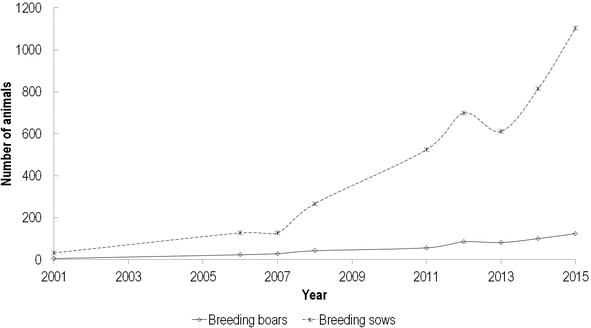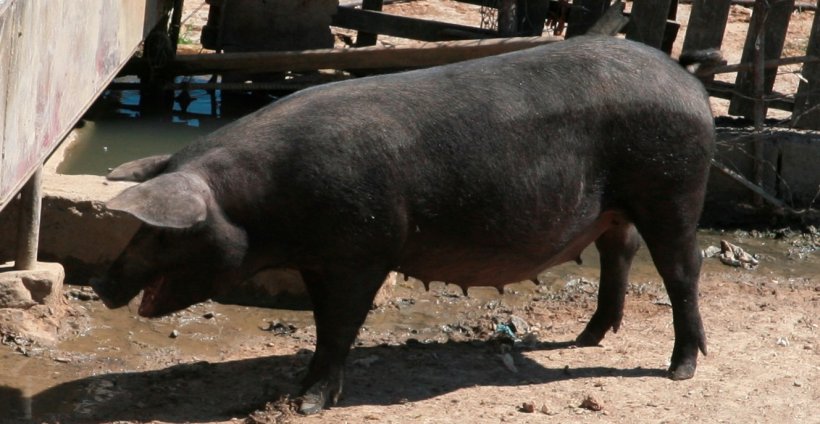History and current status of the breed
The Nero Siciliano is a breed of domestic pig from the Mediterranean island of Sicily, in southern Italy. The breeding of this pig has ancient origins: fossil remains and written documents testify the presence of these animals since the period of Greek and Carthaginian domination (VII-VI century). The pig breeding suffered a setback in the ninth century under Arab domination, while it recovered with the Norman conquest. Numerous breeds and pig populations deriving from the Neapolitan black-haired breed have helped to form this breed that nowadays presents well-defined characteristics. From the early twentieth century, the Nero Siciliano was usually raised in small groups of 10–15 animals and the crossing with other improved breeds was rather diffused. It was not rare at that time to observe white spotted or totally white animals. The breeding of this pig population was widespread on the island until the middle of the twentieth century, and the Nero Siciliano assumed different names in the various geographical areas of breeding. The subsequent socio-economic changes limited the farmed area to the wooded hills of north-eastern Sicily (Madonie and Nèbrodi). Presently, there are 87 registered farms of Nero Siciliano pigs with about 1103 breeding sows and 124 boars in the latest available status (August 2015). Census of Nero Siciliano pig breed is presented in Figure 1.


Exterior phenotypic characteristics
The Nero Siciliano pig breed morphology information is summarised in Table 1. It is a medium-size breed with mainly black coat colour (Figure 2), robust with strong skeleton and black skin and bristles. Some subjects may have a partially or totally white face (‘facciolo’ pig). Head of remarkable development and long, straight profile, narrow and inclined snout; small ears obliquely directed at the top with tips brought horizontally forward. The presence of wattles is tolerated, even if not typical of the breed. Elongated neck and poorly developed trunk, compressed in the thoracic region.
| Measurement (average) | Adult male | Adult female |
|---|---|---|
| Body weight (kg) | 150 | 130 |
| Body length1(cm) | 102 | 87 |
| Height at withers (cm) | 60–65 | 60–65 |
| Number of teats (average) | 11.4 | 11.4 |
1Measured from the tip of the nose to the starting point of the tail.

Geographical location and production system
Nero Siciliano is raised mainly in the province of Messina, particularly in the Monti Nebrodi. The particular orography of this area, characterised by narrow and parallel valleys that end on the coast, favours the natural segregation of the animals, with consequent conservation of an interesting genetic variability. Since 2001, the conservation programme involves a group of companies that adopt the traditional extensive breeding techniques which usually foreseen to let the pigs in forest, if present, during all the year. Depending on climatic conditions the period in the forest could be limited to autumn-winter or spring-summer seasons. The pig breeding has always been present in the farms of the region with the function of recovery and reuse of waste and for their ability to produce supplementary income. It is bred with a fully extensive system by reproducing itself in the bush without any particular precaution using the resources made available by the pastures and the forest. A study of Aronica et al. showed that almost all the farmers (88%) are only responsible of the breeding, whereas other professionals are in charge of processing and selling products.
Productive performance
Reproductive traits
According to survey performed within TREASURE project, the age of sows at first parturition is 30 months, whereas age at culling is 47 months. The only information reporting these traits does not allow making highly reliable inferences but, nevertheless, the relatively low age at culling could be due to the presence both of sows culled after the first event and of sows at the end of their productive life. It is actually quite frequent that the farmer tests the females keeping only some of them for reproductive career. Sows of Nero Siciliano pig breed have 1.1 litters per year with 6.2–9.0 piglets of approximately 1.4 kg live body weight. Stillborn percentage of piglets (0.4 and 4.8%) and piglet mortality rate until weaning (1.3 and 8.9%) are relatively low in the considered studies. As in most of extensive systems of rearing, farrowing interval is prolonged, in comparison to modern intensive systems to 332 days.
Growth performance
Due to big differences between studies with regard to the live weight range covered, we defined the stages for growth performance as early and middle fattening stages estimated between approximately 30 and 60 kg, 60 and 100 kg live body weight, respectively. No studies on late fattening period were found even if, sometimes, the source provided the overall growth rate for the whole fattening stage (defined as overall). It should also be noted that most of the collected studies simulated practical conditions of the production systems used. Only the study of Liotta et al. actually aimed at evaluating the breed potential for growth in ad libitum conditions of feeding, showing that maximal growth rate of Nero Siciliano pigs is 540 g/day in overall fattening stage (observed from 42 to 93 kg live weight). In the considered studies, data for average daily gain in lactation and growing period were not found, whereas reported average daily gains in early, middle and overall fattening stage were low and variable (241–360, 162–465 and 162–600 g/day in early, middle and overall fattening stage, respectively). Also, average daily gain in the period from birth to slaughter (at 18 months of age) observed for Nero Siciliano pig in QUBIC project was much lower compared to modern breeds of pigs (211 g/day).

In considered studies, the information on feed intake and feed nutritional value were scarce, which limits the evaluation of growth potential. Average daily feed intake reported was 1.5–2.2 kg/day in middle fattening stage and 1.7–2.9 kg/day in overall fattening stage. Observing the average feed intakes registered in the different fattening periods and considering the low slaughter weights achieved, it could be argued that the feed transformation efficiency is quite low.
Body composition and carcass traits
In considered studies, the age at slaughter for Nero Siciliano breed ranges from 169 to 730 days of age, with live weight ranges from 62 to 121 kg. These results actually indicating three different orientations of the farmers: one system with older animals and quite high slaughter weights, a second one producing small carcasses with middle age animals (approximately 1 year of age) and a last one devoted to produce light carcasses (60 kg). Dressing yield in considered studies was around 80% and lean meat content varied from 39.7 to 59.0% (SEUROP classification). The back fat thickness value measured on the withers was 52 mm, from 17 to 49 mm at the level of last rib and from 30 to 49 mm above gluteus medius muscle. No data providing measurements of muscularity were found in considered studies.
Meat quality
In the studies reporting meat quality of Nero Siciliano pigs, pH measured in longissimus muscle at 45 min and 24 h post-mortem was on average 6.24 and 5.58, respectively. Intramuscular fat content in the considered studies ranged from 2.7 to 10.0%, increasing with slaughter weight. Colour measured in CIE L, a, b colour space was very variable (46–61, 10.1–15.7 and 4.6–13.4 for L, a* and b*, respectively). SFA, MUFA and PUFA content of intramuscular fat in longissimus muscle were approximately 37.5, 54.2 and 8.3%, whereas SFA, MUFA and PUFA content of back fat tissue in the considered studies were around 39.0, 49.4 and 11.7%, respectively.
Use of breed and main products
The Nero Siciliano breed is raised with a full extensive system. Animals are raised in wide areas of Nebrodi Natural Park (woods of beech and oak trees) limited by fences, exploiting the natural pastures used for grazing: food integration is provided only during the gestation period. In few cases, close to the slaughter weight, the animals are captured and submitted to a finishing phase with a diet based on cereals. Breeders have very small companies and, in most cases, they are also transformers. Their products are intended for family consumption or subject to small local exchanges as well as to local and national markets. The meat of Nero Siciliano is extremely sapid, ruby red coloured, suitable for typical products such as the salami of ‘S.Angelo’, the Troinese sausage, the Nebrodi bacon and the Nicosia ham. The Sant’Angelo salami obtained the PGI since 2008 even if Nero Siciliano could be employed in this production only with cross-bred animals.
Full text and references are available here: Nero Siciliano Pig
Riccardo Bozzi, Maurizio Gallo, Claudia Geraci, Luca Fontanesi and Nina Batorek-Lukač (February 6th 2019). Nero Siciliano Pig, European Local Pig Breeds - Diversity and Performance. A study of project TREASURE, Marjeta Candek-Potokar and Rosa M. Nieto Linan, IntechOpen, DOI: 10.5772/intechopen.84438. Available from: https://www.intechopen.com/books/european-local-pig-breeds-diversity-and-performance-a-study-of-project-treasure/nero-siciliano-pig



